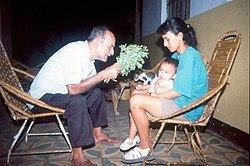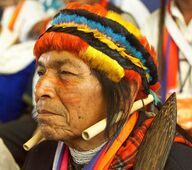Unsolved:Icaro
Icaro (Quechua: ikaro) is a South American indigenous and mestizo colloquialism for magic song.[1] Today, this term is commonly used to describe the medicine songs performed in vegetal ceremonies, especially by shamans in ayahuasca ceremonies.[2][3]
Each Amazonian ethnic group has a specific term for this type of generic magical song: for example, eshuva for the Huachipaire people,[4] meye for the Piaroa,[5] mariri for the Kokama,[6] or rao bewá for the Shipibo.[7]
Etymology
The word icaro is believed to derive from the Quechua verb ikaray, which means "to blow smoke in order to heal".[8][better source needed]
In healing ceremonies
Medicine songs
Icaro is most commonly used to describe the medicine songs used by shamans in healing ceremonies, such as with the psychedelic brew ayahuasca. Traditionally, these songs can be performed by whistling, singing with the voice or vocables, or playing an instrument such as the didgeridoo or flute.[citation needed]
Traditionally, icaros may come to a shaman during a ceremony, be passed down from previous lineages of healers, or come to a shaman during a 'dieta' where plant spirits are believed to teach icaros to the shaman directly. The singing or whistling of icaros is sometimes accompanied by a chakapa, a rattle of bundled leaves.[9] Due to the complexity of certain performance techniques, it may take many years to learn certain icaros, and experienced shamans may be able to recite hundreds of them.[10]
References
- ↑ Nicole., Maxwell (1990-01-01). Witch doctor's apprentice : hunting for medicinal plants in the Amazon. MJF Books. ISBN 1567313035. OCLC 42683849. https://archive.org/details/witchdoctorsappr0000maxw.
- ↑ Pratt, Christina (2007). Ency of Shamanism. The Rosen Publishing Group. pp. 220. ISBN 9781404210400. https://books.google.com/books?id=HltJMMq1_60C&pg=PA220.
- ↑ Luna, Luis Eduardo (1986). Vegetalismo (Stockholm Studies in Comparative Religion). Almqvist & Wiksell Internat. ISBN 91-22-00819-5.
- ↑ "Eshuva, Harákmbut sung prayers of Peru's Huachipaire people - intangible heritage - Culture Sector - UNESCO". http://www.unesco.org/culture/ich/en/USL/eshuva-harakmbut-sung-prayers-of-perus-huachipaire-people-00531.
- ↑ Rodd, Robin; Sumabila, Arelis (2011-03-28). "Yopo, Ethnicity and Social Change: A Comparative Analysis of Piaroa and Cuiva Yopo Use" (in en). Journal of Psychoactive Drugs 43 (1): 36–45. doi:10.1080/02791072.2011.566499. ISSN 0279-1072. http://www.tandfonline.com/doi/abs/10.1080/02791072.2011.566499.
- ↑ Brabec de Mori, Bernd (2011). "Tracing Hallucinations: Contributing to a Critical Ethnohistory of Ayahuasca Usage in the Peruvian Amazon". in Jungaberle, Hendrik. The internationalization of Ayahuasca. Zurich: LIT-Verlag. p. 34. ISBN 978-3-643-90148-4. https://www.academia.edu/5327195.
- ↑ Favaron, Pedro; Bensho, Chonon (2022-07-01). "Rao bewa: los cantos medicinales del pueblo shipibo-konibo". Literatura: Teoría, historia, crítica 24 (2): 139–165. doi:10.15446/lthc.v24n2.102082. ISSN 2256-5450. https://revistas.unal.edu.co/index.php/lthc/article/view/102082.
- ↑ Haule, John Ryan (2011). Jung in the 21st Century: Synchronicity and science. Taylor & Francis. pp. 47–48. ISBN 9780203833605. https://books.google.com/books?id=VkYLhAKQMR8C&pg=PA47.
- ↑ Beyer, Stephan V. (2009) (in English). Singing to the Plants: A Guide to Mestizo Shamanism in the Upper Amazon. Albuquerque: University of New Mexico Press. ISBN 978-0-8263-4729-9. "some songs, such as calling in the spirit of ayahuasca at the start of a ceremony, are performed without rhythmic accompaniment, while healings are all performed with the shacapa."
- ↑ Rozendal, Keith. "Meet Mother Ayahuasca". http://sciencenotes.ucsc.edu/2011/pages/ayahuasca/ayahuasca.html. Retrieved 21 August 2012.
External links
- Sammarco, Francesco (2010). "Icaros—Magical songs of the Amazon". Sacred Hoop (68). https://www.elmundomagico.org/wp-content/themes/elmundomagico/docs/ICAROS.pdf.
 |



